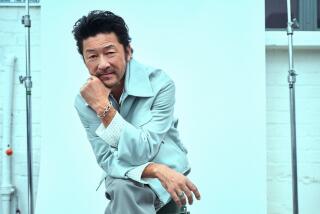From the Archives: Toshiro Mifune, Acclaimed Japanese Film Star, Dies
- Share via
Toshiro Mifune, for decades Japan’s foremost movie star, died Wednesday. He was 77.
Mifune collaborated with director Akira Kurosawa on 16 films between 1948 and 1965, including the classics “Rashomon” and “The Seven Samurai.” But his career included more than 130 films and television dramas.
He was perhaps best known in America for his role as Lord Torinaga in the television miniseries “Shogun” and as the Japanese war commander Admiral Isoroku Yamamoto in the film “Midway.”
Although he displayed great versatility, playing everything from comics to a modern-day cop and a drunken Indian peasant, it was as a samurai warrior devoted to duty and indifferent to pain that he made his most indelible mark.
Mifune died in a hospital in Mitaka, Japan, of what was described only as “organ failure.”
Mifune, a Japanese citizen, was born in Manchuria, a province of China, in 1920 and entered show business after serving in World War II as a photographer in the Japanese air force.
He applied first for a job as an assistant cameraman, but wound up auditioning for acting roles and became one of the preeminent figures of the international cinema.
Mifune was handsome, witty, and charismatic, a real movie hero--as strong, courageous and stoic on the screen as Clint Eastwood. Eastwood, in fact, became a star playing a role inspired by one of Mifune’s. Sergio Leone’s 1964 Western, “For a Few Dollars More,” in which Eastwood proved a sensation as a stoic lone gunman, was a remake of Kurosawa’s 1961 film, “Yojimbo,” in which Mifune played a scruffy, bemused sword for hire.
Eastwood, contacted at his home in Carmel, paid tribute to Mifune.
“Needless to say, I was a great fan of his,” Eastwood said. “I always loved ‘Yojimbo,’ and when I had a chance to do a Western remake I felt it was an opportunity. . . . His performance in ‘Yojimbo’ was definitely an inspiration for me.
“I only met him once, [but] to meet him was like meeting the Asian equivalent of Clark Gable. He will always be the great samurai for us.”
Mifune, though arguably his country’s leading international celebrity after World War II, was understated about his talents. “I’m not always great in pictures,” he once said, “but I’m always true to the Japanese spirit.”
His collaboration with Kurosawa was one of the great screen partnerships. In 1950, Mifune played the bandit in the director’s period masterpiece “Rashomon,” the most crucial of several films that introduced the revived Japanese postwar cinema to the rest of the world. The film had such impact that the word “rashomon,” meaning differing versions of the same incident, has become an expression in the English language.
Four years later, in Kurosawa’s “Seven Samurai,” Mifune played one of the samurai hired by a village to protect it from bandit raids. That film was remade by Hollywood as the Western “The Magnificent Seven,” which spawned several sequels—and, now, a new TV series.
George Lucas has often cited the Kurosawa-Mifune “Hidden Fortress” (1958), a lively samurai adventure, as a key inspiration for “Star Wars.”
An American writer once commented that Mifune, as a heroic samurai, also conveyed the notion that he might like to go to bed with something warmer than his sword.
Mifune was equally at ease in contemporary roles. For Kurosawa, he was memorable as a young man accidentally infected with venereal disease, “The Silent Duel” (1948); a rakish tubercular gangster, “Drunken Angel” (1948); an elderly nuclear protester, “I Live in Fear” (1955); a shrewd, vengeance-seeking businessman, “The Bad Sleep Well” (1960); and a factory owner standing up to his son’s kidnapper, “High and Low” (1964).
Mifune also played the Macbeth role for Kurosawa in “Throne of Blood” (1957), the director’s reworking of the Shakespearean tragedy in the highly stylized manner of Japan’s ancient Noh drama.
He also appeared in a version of Gorky’s “The Lower Depths” (1957) and as a pioneering physician in the 1965 period epic “Red Beard.”
But with “Red Beard,” an especially arduous and time-consuming production, Mifune and Kurosawa came to a parting of ways after 17 years. By then at the height of his international renown, Mifune craved independence—and the opportunity to make better money.
Although he went on to make notable pictures for other directors, he never equaled his achievements with Kurosawa. Although Mifune chose his international roles with care, his English-language films tend to be less impressive than his Japanese works.
Indeed, Mifune was never very comfortable in English, always relying upon an interpreter, although colleagues suspected that he understood more than he let on.
In interviews he was always the polite professional and in social occasions a warm companion. He seemed well aware that he was representing his country around the world and took pains to conduct himself with dignity.
His performances in the United States occasionally prompted cultural debates in his home country.
When he starred in 1980’s “Shogun,” there were complaints in Japan of inaccuracies. Mifune declared that American film and TV writers sometimes “like to take liberties.”
Jerry London, who directed “Shogun,” which was based on James Clavell’s novel, recalled that those who worked with Mifune could not help but marvel at his charisma.
“The amazing thing was when we shot the show he was almost 60, and he wanted to do all his own stunts,” London said. In one scene, Mifune was thrown from his horse, giving the producers a start. He was taken to the hospital but was unhurt.
Several years before, Mifune had demonstrated his star power in Hollywood, when he played Admiral Yamamoto, architect of the attack on Pearl Harbor, in the 1975 Walter Mirisch production “Midway.”
The stir he created was reminiscent of an earlier era. At a press party in his honor at a Century City restaurant, he stood for more than two hours receiving a steady stream of admirers, which included his co-stars Charlton Heston, Henry Fonda, Glenn Ford, Robert Mitchum, Robert Wagner (with his wife Natalie Wood), Robert Webber and James Shigeta.
Though he was relatively inactive in recent years, his place in film history was long secured.
A frequent visitor to Los Angeles, Mifune once served as grand marshal for a Nisei Week parade in Little Tokyo and got an honorary degree from UCLA, becoming only the second actor—after Laurence Olivier—to receive such an award.
He is a survived by a son and his second wife.
Times staff writer Brian Lowry contributed to this story.
More to Read
Start your day right
Sign up for Essential California for the L.A. Times biggest news, features and recommendations in your inbox six days a week.
You may occasionally receive promotional content from the Los Angeles Times.






